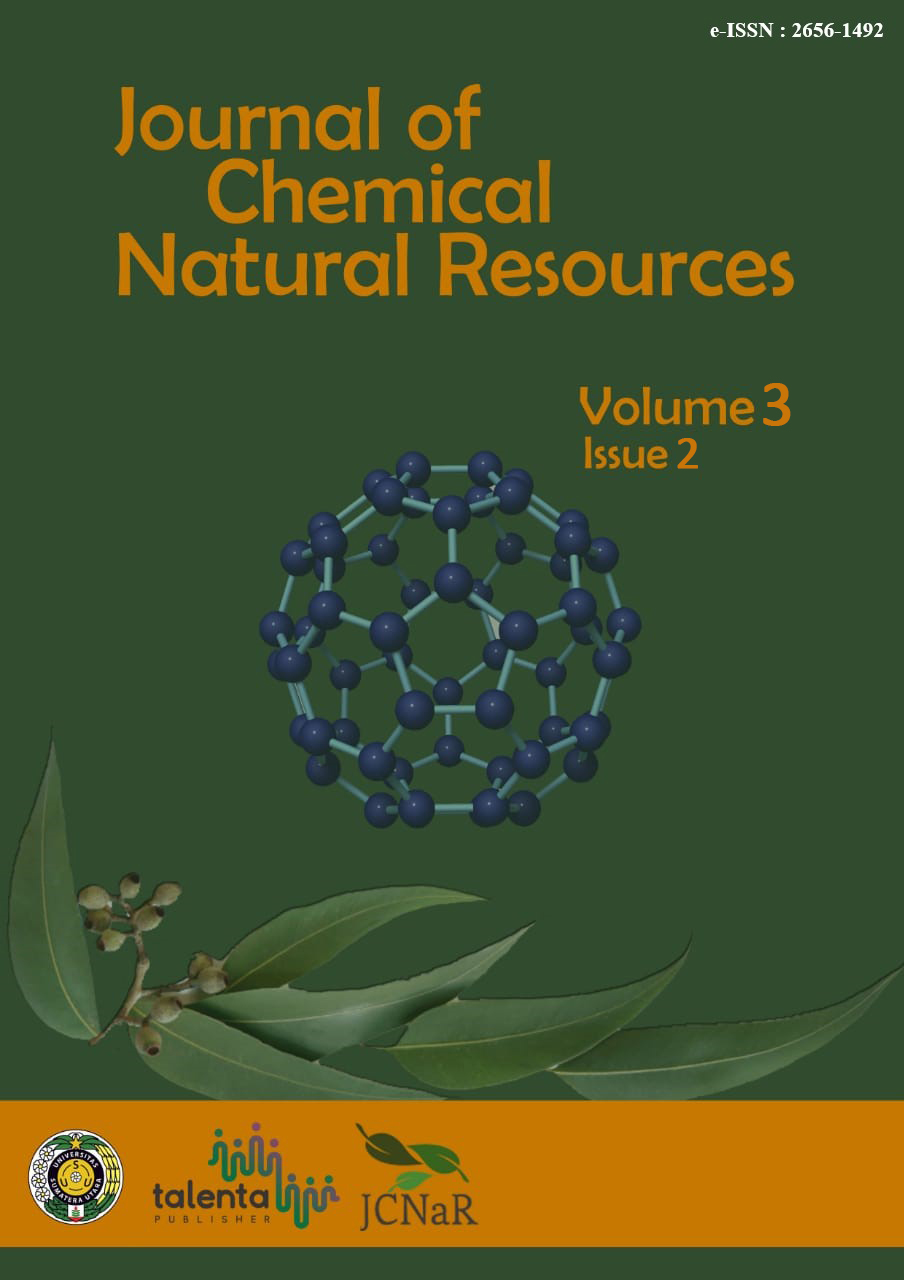Synthesis of Cationic Surfactant N, N-(2-Laurate-Ethyl) Stearamidium Chloride
DOI:
https://doi.org/10.32734/jcnar.v3i2.9362Keywords:
Cationic Surfactant, Surfactant, Du Nouy Ring, Critical Micelle Critical (CMC).Abstract
The cationic surfactant of N, N-(2-Lauric-Ethyl) Stearamidium Chloride had been successfully synthesized. It is long-chain alkyl surfactant derivative from ammonium salt with amide. Cationic surfactants that are synthesized from fatty acid derivatives are stearic acid and lauric acid. Stearic acid is used as stearamide-making material which is the product of methyl stearate amidation with diethanolamine use methoxide sodium catalyst. Lauric acid was used as esterification material with stearamide thus obtaining N, N-(2-Lauric-Ethyl) Stearamide of alcanolamide ester. Alcanolamide ester continued by salting reaction use HCl gas until obtained cationic surfactant of N, N-(2-Lauric-Ethyl) Stearimidium Chloride. Each compound analyzed function groups by FT-IR spectrophotometric with the analyzed change of melting points, and a part compound analyzed surface tension characteristic with measuring Critical Micelle Concentration (CMC) with use Du Nouy ring method. The analysis product obtained shows that methyl stearate by yield in the amount of 91.66% shows that melting point of 40.5°C, stearamide with yield in the amount of 87.6% show that melting point as 185°C by CMC value 0.133 mol/ L in 40.7 dyne/cm surface tension. Alcanolamide ester with a yield in the amount of 84.7% has a melting point of 55°C by a CMC value of 0.067 mol/L in 36.1 dyne/cm surface tension, and cationic surfactant has a melting point of 45°C by CMC value 0.055 mol/L in 31,1 dyne/cm surface tension. stearamide with a yield in the amount of 87.6% show that melting point of 185°C by a CMC value of 0.133 mol/L in 40.7 dyne/cm surface tension. Alcanolamide ester with a yield in the amount of 84.7% has a melting point of 55°C by a CMC value of 0.067 mol/L in 36.1 dyne/cm surface tension, and cationic surfactant has melting point as 45°C by CMC value 0.055 mol/L in 31,1 dyne/cm surface tension. stearamide with a yield in the amount of 87.6% show that melting point of 185°C by a CMC value of 0.133 mol/L in 40.7 dyne/cm surface tension. Alcanolamide ester with a yield in the amount of 84.7% has a melting point of 55°C by a CMC value of 0.067 mol/L in 36.1 dyne/cm surface tension, and cationic surfactant has a melting point of 45°C by CMC value 0.055 mol/L in 31,1 dyne/cm surface tension.
Downloads
References
Attwood, D., 1983. Surfactant Systems. New York: Chapman and Hall
Holmberg, K., 2001. Natural Surfactants. Colloids & Interface Science. 6:148-159.
Johnson, RW, Fritz, E., 1989. Fatty Acids in Industry, Process, Properties, Derivates, Applications. Marcell Dekker Inc. New York.
Ketaren, S., 2008. Introduction to Food Fat and Oil Technology. Jakarta: UI Press.
Kurniasih, E., 2008. Utilization of Distillate Palm Fatty Acids as Raw Material for Dietanolamide Using Lipase (Rhizomucor meihei). Thesis. University of North Sumatra.
Maugard, T., Remaud-Simeon, M., Petre, D. and Monsan, P., 1997. Lipase-catalyzed Synthesis of Biosurfactants by Transacylation of N-Methyl-Glucamine and Fatty-Acid Methyl Esters. Tetrahedron. 53(22): 7629 – 7634.
Pankaj, P., Shaheen, H., and Ahmad, I., 2012. Synthesis of Ester Based Cationic Pyridinium Gemini Surfactants and Appraisal of Their Surface Active Properties. J Surfact Deterg. 16:49-56. JAOCS.
Sharma, J., Batovska, D., Kuwamori, Y. and Asano, Y., 2005. Enzymatic Chemoselective Synthesis of Secondary-Amide Surfactant from N-MethylethanolAmine. Journal of Bioscience and Bioengineering. 100(6): 662-666.
Silverstein, B., 1984. Spectrometric Investigation of Organic Compounds. Fourth Edition. Jakarta: Erlangga.
Soledad, C., Dominguez, P., and Sinisterra, J., 2000. Enzymatic Amidation and Alkoxycarbonylation of Amines Using Native and Immobilised Lipases with Different Origins: A Comparative Study. Tetrahedron, 56:1387 – 1391
Tang, M and Veinardi, S., 2011. Effect of Addition of Organic Solvents on Surface Tension of Soap Solution. Proceedings of the 2011 National Symposium on Learning and Science Innovation (SNIPS 2011). Bandung, Indonesia.
Weni, H., 1997. Report on the Practice of PT SOCI. Chemistry Department. Chemical Analyst D3 Program. USU FMIPA. Medan.
Zhou, M., Zhao, J., and Xiangqi, H., 2012. Synthesis of Bis[N, N'-(alkylamideethyl)ethyl] Triethylenediamine Bromide Surfactants and Their Oilfield Application Investigation. J Surfact Deterg. 15:309-315. JAOCS.
Downloads
Published
Issue
Section
License
Copyright (c) 2022 Journal of Chemical Natural Resources

This work is licensed under a Creative Commons Attribution-ShareAlike 4.0 International License.















